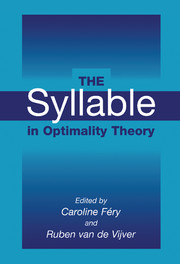Book contents
- Frontmatter
- Contents
- List of Contributors
- Preface
- The Syllable in Optimality Theory
- Part One INTRODUCTION
- Part Two SYLLABLE STRUCTURE AND PROSODIC STRUCTURE
- Part Three NONMORAIC SYLLABLES AND SYLLABLE EDGES
- Part Four SEGMENTS AND SYLLABLES
- 11 On the Sources of Opacity in OT: Coda Processes in German
- 12 Ambisyllabicity and Fricative Voicing in West Germanic Dialects
- 13 The CiV-Generalization in Dutch: What Petunia, Mafia, and Sovjet Tell Us about Dutch Syllable Structure
- 14 The Relative Harmony of /s+Stop/ Onsets: Obstruent Clusters and the Sonority Sequencing Principle
- Part Five HOW CONCRETE IS PHONOTACTICS?
- Author Index
- Languages Index
- Subject Index
13 - The CiV-Generalization in Dutch: What Petunia, Mafia, and Sovjet Tell Us about Dutch Syllable Structure
Published online by Cambridge University Press: 03 July 2009
- Frontmatter
- Contents
- List of Contributors
- Preface
- The Syllable in Optimality Theory
- Part One INTRODUCTION
- Part Two SYLLABLE STRUCTURE AND PROSODIC STRUCTURE
- Part Three NONMORAIC SYLLABLES AND SYLLABLE EDGES
- Part Four SEGMENTS AND SYLLABLES
- 11 On the Sources of Opacity in OT: Coda Processes in German
- 12 Ambisyllabicity and Fricative Voicing in West Germanic Dialects
- 13 The CiV-Generalization in Dutch: What Petunia, Mafia, and Sovjet Tell Us about Dutch Syllable Structure
- 14 The Relative Harmony of /s+Stop/ Onsets: Obstruent Clusters and the Sonority Sequencing Principle
- Part Five HOW CONCRETE IS PHONOTACTICS?
- Author Index
- Languages Index
- Subject Index
Summary
Introduction
Phonotactic considerations suggest that vowels in Germanic languages can be divided into two groups. Characterization of the contrast between these groups is a matter of debate, and it is to this debate that this chapter wants to contribute. Some scholars defend the view that the two groups contrast in length. The members of one group are long while the members of the other group are short (for Dutch: van der Hulst 1984, Kager 1989, Booij 1995; for German: Féry 1995, 1998, Wiese 1996; and for English: Myers 1987, Hammond 1997). Others take the position that the distinction between the groups is a quality distinction. The members of one group are tense, while the members of the other group are lax (for Dutch: van der Hulst 1994, van Oostendorp 1995; for German: Trubetzkoy 1939; and for English: Chomsky and Halle 1968).
A lexical pattern in Dutch, exemplified in section 13.2.2, will be the empirical focus of this chapter. The framework in which the data are analyzed is Optimality Theory (OT – Prince and Smolensky 1993). It might seem strange to use this theory, which is apt at comparing languages, to discuss a lexical pattern in a single language. However, OT is capable of explaining these data in a unified way by means of ranked and violable constraints. In this way OT can characterize a lexical pattern in a single language.
- Type
- Chapter
- Information
- The Syllable in Optimality Theory , pp. 338 - 355Publisher: Cambridge University PressPrint publication year: 2003
- 1
- Cited by



